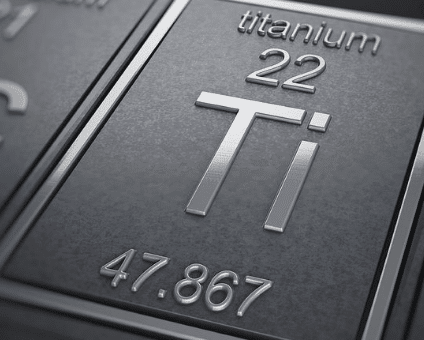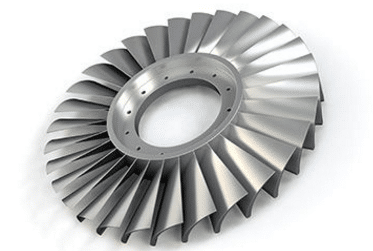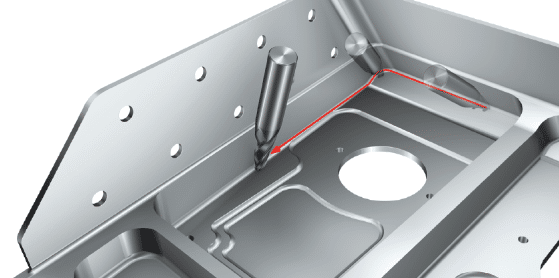Physical phenomena in titanium processing
The cutting force of titanium alloy is only slightly higher than that of steel with the same hardness, but the physical phenomenon of titanium alloy processing is much more complex than that of steel processing, which makes the titanium alloy processing face great difficulties.

Most titanium alloys have very low thermal conductivity, only 1 / 7 of steel and 1 / 16 of aluminum. Therefore, the heat generated in the process of cutting titanium alloy will not be transferred to the workpiece or taken away by the chips, but gathered in the cutting area, the generated temperature can be as high as 1000 ℃ or above, which makes the cutting edge of the tool wear, crack and generate chip tumor rapidly, and the worn cutting edge appears rapidly, which makes the cutting area generate more heat, further shortening the service life of the tool.
The high temperature produced in the cutting process destroys the surface integrity of titanium alloy parts at the same time, which leads to the decrease of geometric accuracy of parts and the phenomenon of work hardening that seriously reduces their fatigue strength.
The elasticity of titanium alloy may be beneficial to the performance of parts, but in the process of cutting, the elastic deformation of workpiece is an important reason for vibration. The cutting pressure makes the “elastic” workpiece leave the tool and rebound, so that the friction between the tool and the workpiece is greater than the cutting effect. The friction process also produces heat, which aggravates the problem of poor thermal conductivity of titanium alloy.
When machining thin-walled or ring shaped parts, this problem is more serious. It is not easy to process titanium alloy thin-walled parts to the expected dimensional accuracy. Because when the workpiece material is pushed away by the cutter, the local deformation of the thin wall has exceeded the elastic range, resulting in plastic deformation, and the material strength and hardness of the cutting point increase significantly. At this time, according to the originally determined cutting speed, the machining becomes too high, which further leads to sharp tool wear.

“Heat” is the “culprit” of titanium alloy difficult to process!
Technological know-how of titanium alloy processing
On the basis of understanding the processing mechanism of titanium alloy and previous experience, the main know-how of processing titanium alloy is as follows:
(1) The blade with positive angle geometry is used to reduce cutting force, cutting heat and workpiece deformation.
(2) Keep constant feeding to avoid hardening of workpiece. During the cutting process, the tool should always be in the feeding state. The radial cutting amount AE should be 30% of the radius.
(3) High pressure and large flow cutting fluid are used to ensure the thermal stability of the machining process and prevent the surface degeneration and tool damage due to the high temperature.
(4) Keeping the blade edge sharp and blunt is the cause of heat accumulation and wear, which is easy to lead to tool failure.
(5) It can be processed in the softest state of titanium alloy as much as possible, because the material becomes more difficult to process after hardening, heat treatment improves the strength of the material and increases the wear of the blade.
(6) Use large tip radius or chamfer to cut in, and try to put more blades into cutting. This can reduce the cutting force and heat at each point and prevent local damage. In the milling of titanium alloy, the cutting speed has the greatest influence on the tool life VC, followed by the radial cut (milling depth) AE.

Starting from blade to solve the problem of titanium processing
The groove wear of the blade in titanium alloy machining is the local wear of the back and front along the cutting depth direction, which is often caused by the hardening layer left by the previous machining. The chemical reaction and diffusion of cutting tool and workpiece material at the processing temperature over 800 ℃ is also one of the reasons for the formation of groove wear. Because in the process of machining, titanium molecules of the workpiece accumulate in front of the blade, and “weld” to the blade under high pressure and high temperature, forming chip accretion tumor. When the chip accretion is peeled from the blade, the cemented carbide coating of the blade is taken away. Therefore, special blade material and geometry are required for titanium alloy processing.
Tool structure suitable for titanium machining
The focus of titanium alloy machining is heat. A large amount of high-pressure cutting fluid should be sprayed on the cutting edge timely and accurately to remove the heat quickly. There is a unique structure of milling cutter specially used for titanium alloy processing on the market.







